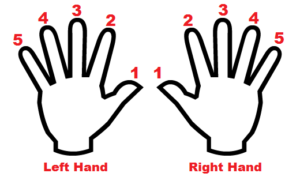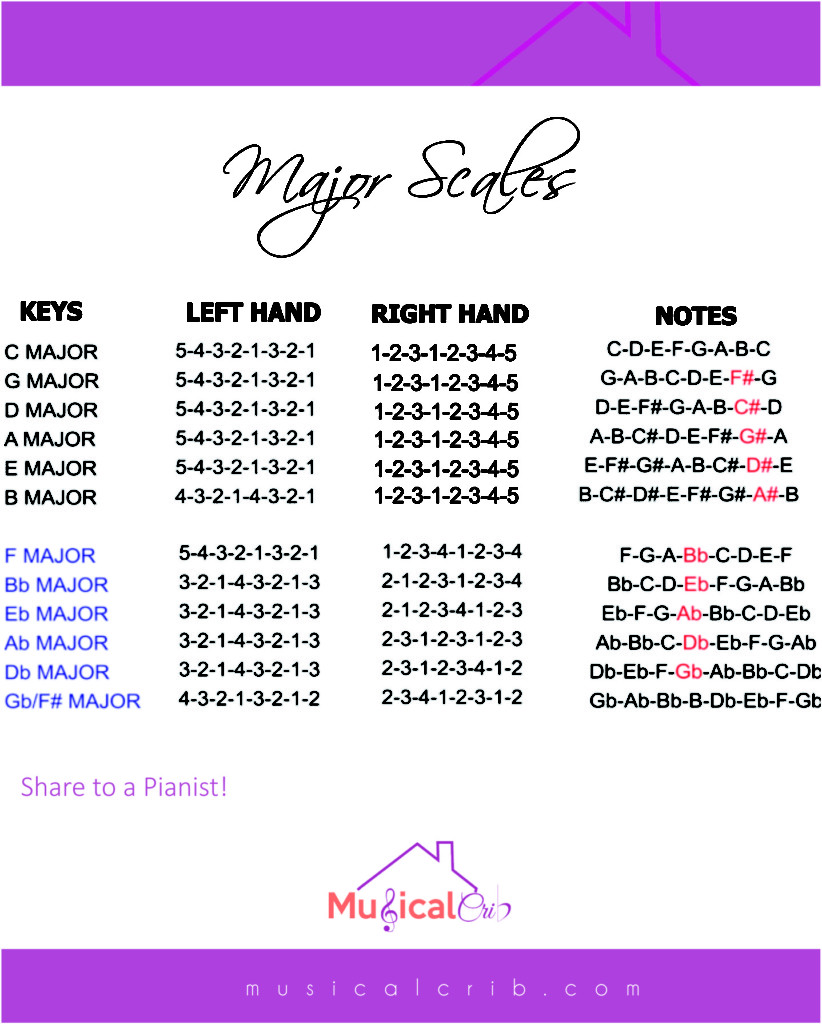Welcome to the Second Post in the series “Practical Way to Play all 12 keys”, in case you missed the first post, you can check it out here.
In this post we will be looking at the major scales and the Chromatic Scale (“major Scales!!!” Yeah, Major Scales). Just as how when you started learning that favorite key, you started by learning the major scale. So the truth is that you can’t play the Chords if you don’t know the major scale of that particular key. So you have to learn to play the major scales of all 12 keys on the piano for you to be able to play on all those 12 keys.
I am sure you all know the formula for the major scale
T-T-ST-T-T-T-ST or W-W-H-W-W-W-H or 1-2-3-4-5-6-7.
Where T stands for Tone, ST- semi tone, W- Whole steps, H-Half steps. You can check out my posts on scales here. You can check out the post on Intervals here Before I thought they all used the same fingering pattern just as how most people think they do right now but that’s not true. I am sure we all know how the fingers are numbered nevertheless this is a diagram below.

Below is an image of the chart of the Major Scales with the appropriate fingering

I would advise you download this image and probably print it out if you can or you draw out this chart.
This Scales will be practiced in relation to the circle of the fifths/fourths.

Why? Because Notes in the circle borrow notes from each other. You’ll notice that by learning the chords in C major first, then moving to G major — you actually play majority of the same chords because keys that are neighbors on the circle are closely related and share majority of the same notes (in fact, the difference in the C major scale and the G major scale is actually just ONE note so it’s not surprising that playing the chord progression in G major almost feels the same as playing it in C major). There are various application/usage of the Circle of the Fifths/Fourth, this is just one of them.
Exercise 1:
The Scales should be practiced on a DAILY basis. (Take note that daily was bolded, it is recommended to be practiced daily at least Monday to Friday if you can’t do Saturday and Sundays or otherwise create special time for it. The scales are to practice on two octaves, ascending and descending. Add this Exercise to your to-do note book.
Note: It is not required of you to practice it with speed. Practice it slowly and steadily making sure your fingers hit each appropriate notes. A metronome will do a great deal. Practice each Key’s Scale per day. It is preferably to dedicate at least 30 mins or run the scale 50 times(ascending and descending) per day and you are expected to practice with both hands ( you might need to practice separate hands to be accurate then you practice both hands). Practice the C major scale the first day. The Next day, Practice the next on the list (which is G). Run it 50 times also then practice the previous ones you learnt alongside the one you just learnt without stopping for about 20 times sequentially ( run C major then G then move back to C then move back to G on both hands) . Practice them SLOWLY!! this might be difficult for most people.. Its BORING !!!! I know but the BORING stuffs makes you better…The fifth in the Circles (C,G,D,A,E,B) won’t give you tough time as the fourth because You use the same fingering for the keys in the circle of the fifth except the left hand fingering for B major. But the fourth??? It gave me tough time, real one. All the fingerings are different.
NB: According to Smallwood, the major scales are to be practiced alongside their relative Minor scales. i.e: after C major, A minor, G major, D minor and so on. That would probably take more time although I would recommend that after you are confident on all 12 major keys the 12 minor keys won’t be difficult.
As you practice, do take note of the relationship that exists between the keys. For instance, The keys in the Circle of the fifth, C-G-D-A-E-B.. Each Succeeding Key has an increase in sharps (or black notes). WHY? Because the notes on the circle of the fifth are all white keys (on the piano) and remember that your 7th is just half step before your root, so definitely it has to be a black key. So those are the additional black keys that are being added as you progress in the circle. In sheet music, they are sharps signifying Key Signatures. Check the table and additional notes from wikipedia here Take a look at the image of the scales above and notice the increase of sharps per succeeding keys in the circle.
Therefore your C major scale has no black keys.
G major scale consists of all the notes on C but has one black note (which will be half step before G)
D major scales consists of all the notes on G but has an additional black note making it 2 black notes, and so on. Take a look at the chart above. So the sharps increase on and on until you get to B, which consist of all the black notes (5 sharps) on the piano thereby making it easier to play..
Same relationship you notice between the keys in the Circle of the fifth exists in the circle of fourth but slightly different. Just as how the fifths in the circle consists of all the white notes, the keys in the fourths are all black keys except F and the increase in flats comes from the fourth.
CHROMATIC SCALE
A chromatic scale is a scale that consist of all the 12 notes in an octave. It is one of the easiest scale to understand because the intervals are all half steps. It is paramount to understand and be able to play the chromatic scale rightly as it aids in playing on all 12 keys. It also has a fingering pattern.
Left Hand (Ascending): 4-3-1-3-2-1-3-1-3-1-3-2-1-3-1-3-2-1-3-1-3-1-3-2
Descending: 1-2-3-1-3-1-3-1-2-3-1-3-1-2-3-1-3-1-3-1-2-3-1-3-4
Right Hand (Ascending): 1-3-1-3-1-2-3-1-3-1-3-1-2-3-1-3-1-2-3-1-3-1-3-1
Descending: 2-1-3-1-3-1-3-2-1-3-1-3-2-1-3-1-3-1-3-2-1-3-1-3-1
EXERCISE 2:
Practice the Chromatic Scale on two octaves ascending and descending on a daily basis also. You can dedicate 10 mins to it. Please make sure you practice it with the appropriate fingering and note that you don’t have to rush it. This scale can be rehearsed separately on each hands and then be rehearsed together. Gradually increase speed every day.
Tips:
For Right Hand: Most white keys will be played with your thumb (finger 1).
The notes C and F will be played with your index finger (finger 2).
All black notes will be played with your middle finger (finger 3)
For Left Hand: : Most white keys will be played with your thumb (finger 1).
The notes E and B will be played with your index finger (finger 2).
All black notes will be played with your middle finger (finger 3)
Please do ensure you start the practice of these two exercises appropriately and daily…You can always drop your questions in the comment box and it will be attended to. .If you feel you need to have a physical session with me to really understand or clear some points you can always contact me. My profile should be just below this post…..

